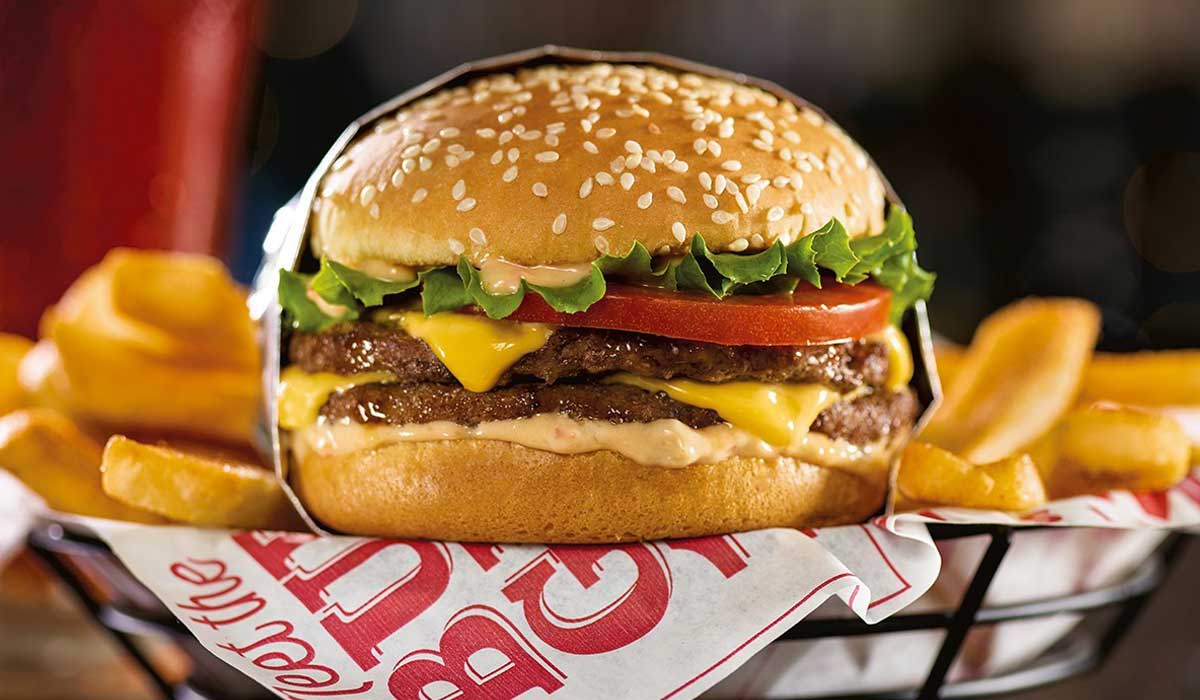COVID-19 conditions have weighed heavily on Red Robin in recent weeks, although the burger chain’s to-go business is picking up.
The company announced Tuesday it’s temporarily closed 35 corporate restaurants—the majority of which are mall-based locations. As a result, Red Robin furloughed affected restaurant managers and employees, it said. Some were transferred to nearby locations where possible.
Additionally, Red Robin temporarily reduced pay by about 20 percent for all non-furloughed restaurant support center and supervisory employees, effective April 20. It also eliminated roughly 50 support center G&A positions (active April 17), and is engaging in “constructive discussions” with landlords regarding the potential restructuring of lease payments. Red Robin said the process is ongoing.
CHECK OUT HOW DARDEN’S SALES ARE TRACKING DURING COVID-19
The 550-plus unit chain is in the final week of its fiscal first quarter. And things were off to a solid start pre-COVID-19.
In the period through March 23, same-store sales were up 3.4 percent, year-over-year.
Here’s how that progressed (same-store sales versus prior-year period):
- Week ending March 1: 0.9 percent
- Week ending March 8: –3.7 percent
- Week ending March 15: –26.3 percent
- Week ending March 22: –72.7 percent
- Week ending March 29: –70.5 percent
- Week ending April 5: –63.9 percent
- Week ending April 12: –65.2 percent
While this dramatic chart unfolded, Red Robin’s off-premises sales per restaurant lifted:
- Through February 23: $7,674
- Week ending March 1: $8,264
- Week ending March 8: $7,963
- Week ending March 15: $7,534
- Week ending March 22: $13,172
- Week ending March 29: $18,259
- Week ending April 5: $20,782
- Week ending April 12: $19,033
The final week included the Easter holiday weekend, which was one week earlier than the prior year.
“We continue to be focused on protecting the health and safety of our team members and guests, and are taking additional actions to preserve liquidity, reduce costs, and better position Red Robin for the long term,” CEO Paul Murphy said in a statement. “These include both short- and longer-term initiatives that will enable the Company to more effectively benefit from an eventual recovery in on-premise sales as the impact of COVID-19 subsides. At the same time, we continue to be encouraged by the strong growth in our off-premise sales, which is helping to reduce the impact of the temporary closures on the dine-in business.”
Red Robin has implemented several initiatives over the last month, including a “pre-work symptom survey,” to ensure employees aren’t sick and are sent home when they show any signs. It’s also sealing to-go bags and pizza boxes with tamper-proof stickers and encouraging guests to remain in their cars for pickup.
Red Robin has designated curbside parking spots where customers can see signs with a phone number to call when they’ve arrived.
The chain also reduced its menu options April 2 to streamline kitchen and supply chain. It’s calling this the “Best Of” menu. It features alcohol where available by law as well.
Red Robin is offering 20 percent of online gift cards for a limited time, too, and free direct delivery through its site.
The company last provided an update in early April saying it had more than doubled its off-premises sales in a two-week span. It also revealed that it drew down on the remaining capacity in its $300 million credit facility, which brought the brand’s cash balance to more than $91 million as of March 29.
Executive salaries were reduced by 20 percent, effective March 30, and board member cash retainer fees were sliced by the same amount.
The company decided to postpone the rollout of Donatos pizzas in an effort to eliminate non-essential spending on capital expenditures, planned growth, and other initiatives like restaurant redesigns and IT projects. Before the pandemic, Red Robin planned to shake up its menu by bringing pizza—via Donatos—to 100 restaurants in 2020 then 150 each in 2021 and 2022
In Q4, Red Robin’s off-premises business increased 26.9 percent to 13.9 percent of food and beverage sales.
Q4 same-store sales increased 1.3 percent to give Red Robin two consecutive periods of positive gains. That after reporting negative in seven of the previous eight and 12 of the last 14.
The company’s net loss in Q4 narrowed to $7.7 million, or 60 cents per share, from $10.6 million (82 cents per share) in the year-ago period. Adjusted net loss was $4.7 million versus adjusted net income of $5.4 percent in Q4 2018. Total revenues decreased 1.2 percent, year-over-year, to $302.9 million. Restaurant revenue fell $4.1 million due to a $7.8 million decrease from restaurant closures, partially offset by the comps growth.
Red Robin’s 1.3 percent same-store sales performance was weighed down by traffic. Q4 average check lifted 4.1 percent, thanks to a 1.1 percent increase in menu mix and 1.8 percent hike in pricing, and a 1.8 percent uptick from lower discounting. Guest counts fell 3.4 percent.
Red Robin finished fiscal 2019 with 556 total restaurants. It closed five units and sold 12 to franchisees in Q4. For the full calendar, the chain shuttered 18 locations (all company owned). There were 573 total units as of December 30, 2018. Red Robin headed into 2020 with 102 franchises versus 89 this time last year, and 454 corporate locations compared to 484.







